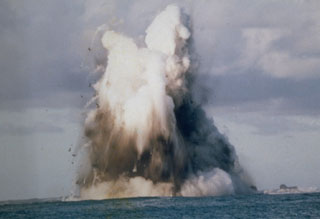Report on Nishinoshima (Japan) — 26 February-3 March 2020
Smithsonian Institution / US Geological Survey
Weekly Volcanic Activity Report, 26 February-3 March 2020
Managing Editor: Sally Sennert.
Please cite this report as:
Global Volcanism Program, 2020. Report on Nishinoshima (Japan) (Sennert, S, ed.). Weekly Volcanic Activity Report, 26 February-3 March 2020. Smithsonian Institution and US Geological Survey.
Nishinoshima
Japan
27.247°N, 140.874°E; summit elev. 100 m
All times are local (unless otherwise noted)
The Japan Coast Guard (JCG) presented InSAR results from 17 November 2019 to 28 February 2020 showing growth of Nishinoshima’s central cone alomg with changes to the island’s surface and expansion of the coastline from lava flows. During an overflight on 17 February observers noted continuous activity from the central vent, including a diffuse ash plume rising about 600 m. Ejected material landed near the cone’s base. Lava flowed into the sea at the N and E coasts, causing a rising steam plume. Discolored water had been seen on 4 February in an area 9 km S of the island but was not apparent during the overflight possibly due to weather conditions. The marine exclusion zone was defined as a radius of about 2.6 km from the island.
Geological Summary. The small island of Nishinoshima was enlarged when several new islands coalesced during an eruption in 1973-74. Multiple eruptions that began in 2013 completely covered the previous exposed surface and continued to enlarge the island. The island is the summit of a massive submarine volcano that has prominent peaks to the S, W, and NE. The summit of the southern cone rises to within 214 m of the ocean surface 9 km SSE.
Source: Japan Coast Guard

